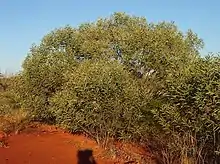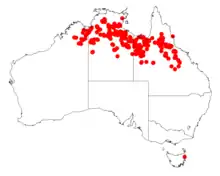Acacia gonoclada
Acacia gonoclada, also known as ganambureng,[1] is a tree or shrub belonging to the genus Acacia and the subgenus Juliflorae that is endemic to northern Australia.
| Ganambureng | |
|---|---|
 | |
| Scientific classification | |
| Kingdom: | Plantae |
| Clade: | Tracheophytes |
| Clade: | Angiosperms |
| Clade: | Eudicots |
| Clade: | Rosids |
| Order: | Fabales |
| Family: | Fabaceae |
| Subfamily: | Caesalpinioideae |
| Clade: | Mimosoid clade |
| Genus: | Acacia |
| Species: | A. gonoclada |
| Binomial name | |
| Acacia gonoclada | |
 | |
| Occurrence data from AVH | |
Description
The spindly tree or shrub typically grows to a height of 0.5 to 4 metres (2 to 13 ft).[2] It has smooth, red-brown or grey coloured bark and angular olive-green to brown branchlets. Like most species of Acacia it has phyllodes rather than true leaves. The evergreen flat phyllodes have an elliptic or oblanceolate shape with a length of 5 to 13.5 cm (2.0 to 5.3 in) and a width of 8 to 33 mm (0.31 to 1.30 in). They are narrowed and curved upwards toward the base and have two or three obvious main veins.[1] It blooms from May to September producing yellow flowers.[2] The cylindrical flower-spikes occur singly or in pairs and are found in terminal panicles and have a length of 1 to 5 cm (0.39 to 1.97 in) with bright yellow flowers. The flat and linear seed pods that form after flowering are clustered in the upper axils. The thin, glabrous and resinous pods are slightly constricted between seeds and have a length of 2 to 6 cm (0.79 to 2.36 in) and taper toward the base and apex. The black seeds inside are arranged longitudinally and have an oblong to broadly elliptic shape with a length of 3 to 4 mm (0.12 to 0.16 in) and have an open narrow areole.[1]
Taxonomy
The species was first formally described by the botanist Ferdinand von Mueller in 1859 as part of the work Contributiones ad Acaciarum Australiae Cognitionem as published in the Journal of the Proceedings of the Linnean Society, Botany. It was reclassified as Racosperma gonocladum by Leslie Pedley in 1987 then transferred back to genus Acacia in 2001.[3]
Distribution
It is native to an area in the Kimberley region of Western Australia[2] across the top end of the Northern Territory and central Queensland. It is found in tropical areas and grows in shallow stony soils and loamy soils.[1]
See also
References
- "Acacia gonoclada". World Wide Wattle. Western Australian Herbarium. Retrieved 19 October 2019.
- "Acacia gonoclada". FloraBase. Western Australian Government Department of Biodiversity, Conservation and Attractions.
- "Acacia gonoclada F.Muell. Ganambureng". Atlas of Living Australia. Global Biodiversity Information Facility. Retrieved 19 October 2019.